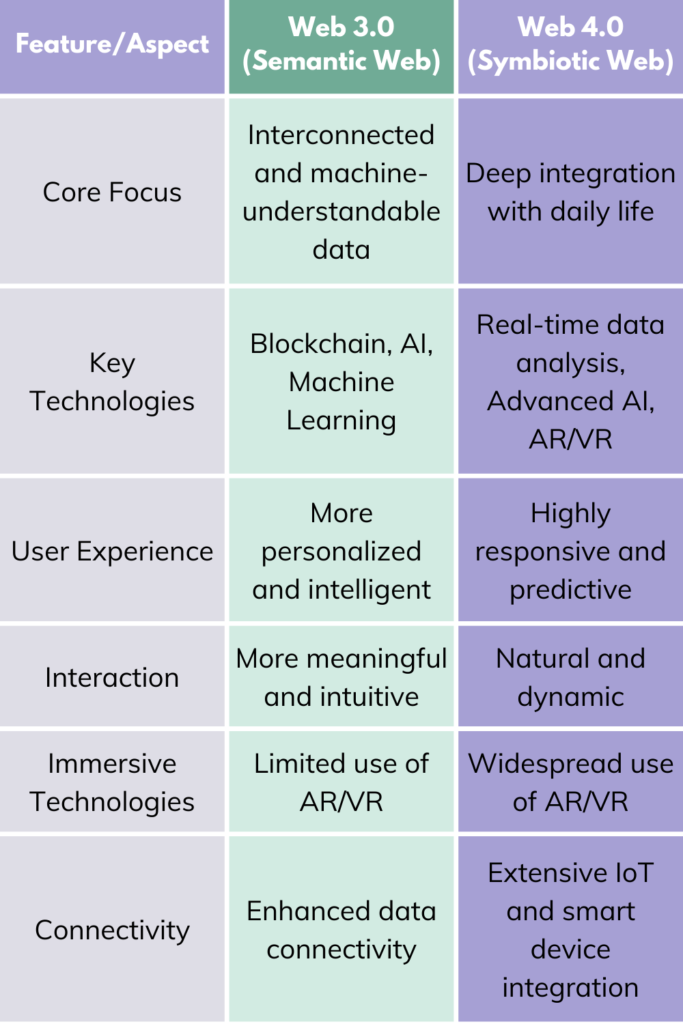Web 4
Web 4.0 services are independent, proactive, self-learning, work together, and create their own content. Semantic and reasoning technologies that are fully developed and AI make up the base. Intelligent agents help them use and take care of Web databases. Services that interact with sensors and implants, services that use natural language, and virtual reality services are all examples.
The goal of Web 4.0 is to give it even more, intelligence and sophistication. Our software agents that move around the Internet may talk to other software agents. They work together to make systems that help us get things done.
As Web 4.0 develops, it will make it possible for people and machines to work together in new ways. The rise of Web4.0 connectivity between people and machines has already begun. Alarm systems and cable companies are two different types of service providers, but when they work together, it’s to your benefit. Consumers can therefore access low-cost security solutions using existing broadband connections and low-cost web cameras.
Web 4.0 characteristics
- The Web is an operating system in and of itself. Communication of the data is possible from anywhere on Earth.
- A lot of artificial intelligence is used in the way the Internet works, which makes the chances that are offered better overall.
- People can talk to each other over the Internet in the same way they talk to each other.
- On the internet, you can see everything and find out where it came from.
At the current growth point, the Internet provides faster and more reliable service than before.
Read-only websites gave way to the feature-rich Semantic Web of today on the Internet. Web 4.0 will soon replace it since it offers a solid connection between humans and machines to produce interactive data. Blockchain initiatives like Free TON, ChainLink, and Polkadot facilitate the speedier growth of the Internet. Decentralized financing (DeFi), decentralized apps (dApps), and non-fungible tokens are just a few of the advancements that cryptocurrency and blockchain have brought to the Internet (NFT). Man and machine will coexist in harmony due to integrating new technology into daily life. Virtual reality will increasingly leverage big data. Due to the use of RFID tags,
enhance inter-machine communication Artificial intelligence will allow these systems and programs to recognize the demands of their users. Web 4.0 will soon take over from Web 3.0.
This is quite similar to the practice of “flipping homes,” in which a home is purchased, then remodelled to sell it for a profit as rapidly as possible. In this case, the goal is to sell the home as quickly as possible. However, in contrast to the home flipping process, you won’t often need to change the domain name to see an increase in its worth.
The fact that it doesn’t need a lot of time or effort to get from purchasing a domain to selling one makes it such an excellent “side business.” However, This also shows that when it comes to successfully flipping domain names, timing is everything. You need to be in the right location at the right moment to purchase a desirable domain name before it is purchased by someone else or given a premium price.
Web 3.0 vs. Web 4.0
Each step of Web 3.0 to Web 4.0 brings new technology and user experience, changing how we use the internet.
Web 3.0, often known as the “semantic web,” focuses on making data more linked and machine-understandable. Blockchain, artificial intelligence, and machine learning provide more customized and smarter online experiences in this edition. These technologies attempt to make Web 3.0 more natural and user-centric, making material readily accessible and interactions more meaningful.
Web 4.0, sometimes known as the “symbiotic web,” integrates the internet into our daily life. Using real-time data analysis and advanced AI, this age promises a dynamic online that predicts user demands. Web 4.0 will enable more immersive experiences, including widespread usage of AR and VR, which will blur the barriers between physical and digital places. This degree of integration will make web-user interaction more natural and dynamic.
Web 4.0 should also enable a more independent and decentralized web infrastructure. Many smart gadgets and the Internet of Things (IoT) will connect and collaborate without human involvement. From smart houses to intelligent transportation systems, connectivity and automation will simplify everyday living.
Web 3.0 makes the internet smarter and more connected, but Web 4.0 embeds it into our physical surroundings and creates a more intuitive, interactive, and automated online experience. Web 3.0 to Web 4.0 represents a breakthrough toward a more intelligent and interconnected online ecology.

Conclusion
Web 3.0 to Web 4.0 changed our online experience. Web 3.0’s semantic web uses blockchain, AI, and machine learning to make online experiences more customized and intuitive. Content and interactions are more accessible and meaningful after this phase.
Web 4.0 integrates the internet into our everyday lives even further. Web 4.0 promises a more responsive and predictive online environment with AI, real-time data processing, and AR and VR. This new internet age allows people and robots to work together more naturally and dynamically.
Web 4.0’s decentralized architecture, driven by the Internet of Things and intelligent agents, will automate and simplify daily living. Web 4.0 connection and automation will improve online ecosystems from smart homes to smart transportation networks.
As we migrate to Web 4.0, the internet will become smarter, more interconnected, and a vital component of our physical world, improving our lives, work, and interactions. This shift toward a more intelligent and symbiotic web marks a new era in the digital age, where humans and machines will collaborate to innovate and improve life.
